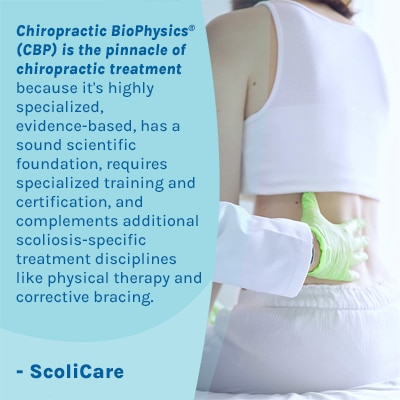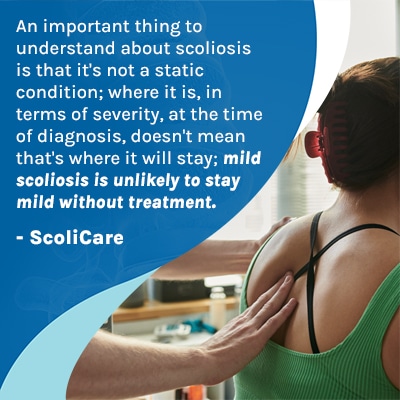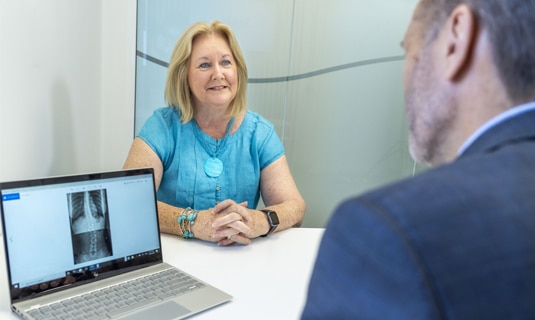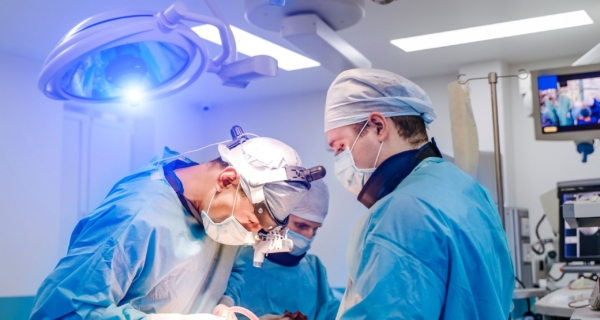There is more than one way to treat scoliosis, and the right treatment plan can improve the spine’s long-term health and function. Scoliosis is a complex condition; there are many different types and severity levels, and while treatment results can never be guaranteed, scoliosis-specific chiropractic treatment can be integrated into a proactive treatment plan.
It’s important to understand that as a progressive condition, scoliosis treatment is ongoing, but it can be highly treatable. While surgical intervention was a dominant treatment choice for years, an evidence-based nonsurgical treatment alternative, involving scoliosis-specific chiropractic treatment, has developed.
In many cases of scoliosis, we don’t know what causes its initial onset, but we know how to respond with treatment, and this is important because it can shape a patient’s long-term spinal health and quality of life.
Understanding Scoliosis
Scoliosis causes the spine to bend unnaturally to the side and twist; the rotational component is what makes scoliosis a 3-dimensional condition (1).
As a progressive condition, the nature of scoliosis is to become more severe, and this means the spine’s unnatural spinal curvature is likely to increase in size and the condition’s effects will become more noticeable (1).
And for patients experiencing pain, this can also increase alongside compression, particularly in adults.(2).
In young patients whose spines are still growing, the lengthening motion of growth increases risk of progression, and although most don’t have pain, it can exist in these adolescents (3). For adults with scoliosis, pain is common. 2).
An important thing to understand about scoliosis is that it’s not a static condition; where it is, in terms of severity, at the time of diagnosis, doesn’t mean that’s where it will stay; mild scoliosis is unlikely to stay mild without treatment (4, 5).
Scoliosis can be diagnosed as mild, moderate, or severe scoliosis (5), and there are also different types from idiopathic scoliosis to neuromuscular and degenerative scoliosis; different types have unique treatment needs, and adolescent idiopathic scoliosis is the most prevalent type overall.
Progressive conditions need to be treated proactively to counteract their progressive nature (4, 5, 6).
It’s also important to understand that scoliosis is a structural spinal condition, meaning there is an abnormality within the spine itself, so treatment also has to impact the condition’s underlying structural nature.
And remember, scoliosis doesn’t just cause the spine to bend unnaturally to the side; the spine also twists and translates, so its rotation and translation has to also be addressed (5).
So where does chiropractic treatment come in?
Chiropractic Treatment
Most people see chiropractors for back injuries, to help with pain management, and to maintain a good range of motion in the spine.
At ScoliCare, we have a multidisciplinary team across the globe, many of which include chiropractors trained specifically in scoliosis management.

On the flip side of this, a scoliosis patient undergoing general chiropractic care is more about addressing the symptoms of scoliosis than correcting the scoliosis itself.
The complexity of scoliosis is beyond the scope of general chiropractic treatment, but adjunctive chiropractic treatment, particularly when combined with specific types of corrective treatment, may have the potential to improve other symptoms the patient is experiencing, such as pain.
Chiropractic BioPhysics® (CBP) is the pinnacle of chiropractic treatment because it’s highly specialized, evidence-based, has a sound scientific foundation, requires specialized training and certification (7, 8), and complements additional scoliosis-specific treatment disciplines like scoliosis specific exercise rehabilitation and corrective bracing.
CBP is evidence-based chiropractic treatment that combines the best of what chiropractic, anatomy, physiology, physical therapy, and biology have to offer; chiropractic treatment that’s scoliosis-specific relies on a series of techniques and manual adjustments to significantly improve spinal alignment and reduce the curve size (7, 8).
Chiropractic BioPhysics® focuses on postural correction so the spine is held in a healthier position and spinal decompression can help stretch the spine, taking pressure off discs, nerves, and muscles (7, 8).
Reducing the size of a scoliosis means decreasing the uneven forces of the condition and restoring the body’s alignment in addition to the spine’s position (5).
Chiropractic treatment can also help increase the spine’s flexibility, making it more responsive to treatment, providing pain relief and taking pressure off compressed nerves (7, 8).
When combined with the power of scoliosis-specific exercise, the improvement to the spine’s position is better supported and stabilized as the spine’s surrounding muscle balance and strength are improved.
So chiropractic treatment for scoliosis may be effective as an adjunctive treatment, but it needs to be a part of an entire wholistic scoliosis-specific rehabilitation program. The team at ScoliCare are well versed in working alongside other health professionals to ensure a holistic approach to treatment.
ScoliBalance®
ScoliBalance® is a complete program for addressing scoliosis in children, adolescents, and adults of all ages (9).
Designed by chiropractor, Dr. Jeb McAviney, and physical therapist Rose Mirenzi, ScoliBalance® combines the best of what scoliosis-specific chiropractic care and established scoliosis-specific exercise-based treatment programs like the Schroth Method and the Scientific Exercise Approach to Scoliosis (SEAS) has to offer (9).
Delivered in accordance with SOSORT (International Society on Scoliosis Orthopedic and Rehabilitation Treatment) guidelines (5), ScoliBalance® is individualized to address the specifics of each patient’s condition type, severity, location within the spine, posture, and spinal flexibility (9).
Not only does ScoliBalance® include scoliosis-specific care based on concepts such as Mirror Image® from Chiropractic Biophysics, ScoliBalance® uses the power of corrective exercise to realign the spine, improve the spine and body’s alignment, flexibility, while also targeting the spine’s surrounding muscle balance and strength (9).
Through the use of Mirror Image® exercise, patients are taught how to be mindful of spine and body position; the way patients hold their bodies during movement and rest can help counteract the scoliosis and improve posture for a straighter alignment and a more balanced spine and body.
ScoliBalance® is also used for larger curves in conjunction with the prescription of corrective 3D bracing, and relies on the ScoliBrace® (9).
ScoliBrace®
The ScoliBrace® is a custom 3-dimensional scoliosis brace that’s evidence-based and customized to address the specifics of a patient’s posture, scoliosis type, and severity (4).
The ScoliBrace® individualizes potential corrective results through the use of an overcorrective approach to improve spinal alignment and balance through spinal coupling, and as the spine is held in an overcorrective position in the brace, the brain and body are being retrained together to maintain this position out of the brace.
The ScoliBrace®, harnesses principles of spinal coupling, over-correction and Mirror Image®, particularly for adolescents with idiopathic scoliosis, (7, 8). These are principles that are fundamental components of Chiropractic Biophysics (7, 8) methods and teachings. This complements each other as they are working towards the same goal of improving the spine’s position and body posture (7, 8, 9).
What’s also unique about the ScoliBrace® is that while many traditional scoliosis braces immobilize the spine, the ScoliBrace® was designed with movement in mind, so it can be integrated into a multifaceted treatment plan that combines the power of scoliosis-specific exercise rehabilitation in the form of ScoliBalance® (9). Clinicians who are also trained and certified in the Chiropractic Biophysics method, as well as ScoliBrace® and ScoliBalance®, provide a well-rounded and comprehensive treatment plan. By these different facets of treatment working together, the spine’s flexibility and strength can be preserved (9), scoliosis can be impacted on multiple levels, and surgical intervention may be avoided (10).

To be clear, general Chiropractic treatment can include adjustments of the spine, and should not be used as a replacement for industry accepted and evidence based methods such as 3D corrective bracing and scoliosis specific exercise (5). Non-surgical management should be prioritized in the form of 3D corrective bracing and scoliosis specific exercise programs as per international guidelines and research (5). Other treatments are considered adjunctive.
Conclusion
When it comes to scoliosis, it’s important to understand that as a progressive condition, how a scoliosis diagnosis is responded to with treatment can have far-reaching effects.
Effective scoliosis treatment should be started as early as possible; while there are never treatment guarantees, there are direct links between early diagnosis, proactive treatment, and treatment success.
Scoliosis that’s left untreated can continue to progress and cause complications that may have been avoidable had a proactive nonsurgical treatment plan been applied earlier.
The ScoliCare approach to nonsurgical scoliosis treatment is modern and integrative; it combines the potential of, scoliosis-specific exercise, and 3D corrective bracing, combined with the use of Chiropractic BioPhysics® principles, and it values the timing of when treatment is started.
While surgical intervention still has a place in scoliosis treatment, scoliosis surgery is invasive and doesn’t have as much potential to preserve the spine’s natural strength and flexibility as the ScoliCare approach can offer.
When chiropractors are well trained in scoliosis specific care that utilizes 3D corrective bracing and scoliosis specific exercise rehabilitation, they may be well placed to be part of a holistic team to manage scoliosis.
References:
- Weinstein SL. The Natural History of Adolescent Idiopathic Scoliosis. J Pediatr Orthop. 2019 Jul;39(Issue 6, Supplement 1 Suppl 1):S44-S46. doi: 10.1097/BPO.0000000000001350. PMID: 31169647
- Zaina, F., Marchese, R., Donzelli, S., Cordani, C., Pulici, C., McAviney, J., & Negrini, S. (2023). Current knowledge on the different characteristics of back pain in adults with and without scoliosis: a systematic review. Journal of Clinical Medicine, 12(16), 5182.
- Theroux, J., Stomski, N., Hodgetts, C. J., Ballard, A., Khadra, C., Le May, S., & Labelle, H. (2017). Prevalence of low back pain in adolescents with idiopathic scoliosis: a systematic review. Chiropractic & manual therapies, 25(1), 10.
- Negrini, S., Grivas, T. B., Kotwicki, T., Maruyama, T., Rigo, M., Weiss, H. R., & members of the Scientific society On Scoliosis Orthopaedic and Rehabilitation Treatment (SOSORT) stefano. negrini@ isico. it. (2006). Why do we treat adolescent idiopathic scoliosis? What we want to obtain and to avoid for our patients. SOSORT 2005 Consensus paper. Scoliosis, 1(1), 4.
- Negrini, S., Donzelli, S., Aulisa, A. G., Czaprowski, D., Schreiber, S., de Mauroy, J. C., … & Zaina, F. (2018). 2016 SOSORT guidelines: orthopaedic and rehabilitation treatment of idiopathic scoliosis during growth. Scoliosis and spinal disorders, 13(1), 3.
- Palazzo, C., Montigny, J. P., Barbot, F., Bussel, B., Vaugier, I., Fort, D., … & Marty-Poumarat, C. (2017). Effects of bracing in adult with scoliosis: a retrospective study. Archives of Physical Medicine and Rehabilitation, 98(1), 187-190.Oakley PA, Harrison DD, Harrison DE, Haas JW. Evidence-based protocol for structural rehabilitation of the spine and posture: review of clinical biomechanics of posture (CBP) publications. J Can Chiropr Assoc. 2005 Dec;49(4):270-96. PMID: 17549209; PMCID: PMC1840024
- Haggard, J. S., Haggard, J. B., Oakley, P. A., & Harrison, D. E. (2017). Reduction of progressive thoracolumbar adolescent idiopathic scoliosis by chiropractic biophysics®(CBP®) mirror image® methods following failed traditional chiropractic treatment: a case report. Journal of Physical Therapy Science, 29(11), 2062-2067.
- Marchese R, Du Plessis J, Pooke T, McAviney J. The Improvement of Trunk Muscle Endurance in Adolescents with Idiopathic Scoliosis Treated with ScoliBrace® and the ScoliBalance® Exercise Approach. J Clin Med. 2024 Jan 23;13(3):653. doi: 10.3390/jcm13030653. PMID: 38337346; PMCID: PMC10856658
- Marchese, R., Du Plessis, J., Pooke, T., & McAviney, J. (2024). The improvement of trunk muscle endurance in adolescents with idiopathic scoliosis treated with ScoliBrace® and the ScoliBalance® exercise approach. Journal of Clinical Medicine, 13(3), 653.


